Why “Things That Matter” really do matter: Part 4: The Alternative

- Part 1: What are “Things That Matter”?
- Part 2: What are we currently doing?
- Part 3: Why aren’t the Things That Matter working?
- Part 4: What’s the alternative?
- Part 5: Why does it work?
“Things That Matter” is the foundation of our Value Management approach.
But it seems obvious what it means, and even more obvious that the Things That Matter are what everything we do should be centered on. So, what more is there to say? What does this add that people aren’t already doing? What are the big insights here?
This series answers these questions – and many others – to show precisely how and why the Things That Matter really do matter, and so let’s continue with the process behind the phrase “Things That Matter”.
The alternative: a Things That Matter-led process
We’ve seen so far in this series that – despite what we might assume – we’re actually in a mess when it comes to the Things That Matter, and it’s only going to get worse.
The good news is that there is a way forward, and that’s because the “Things That Matter” isn’t just a phrase or a concept; it’s also a process, and it begins with the Scope & Surface step.
1. Scoping and Surfacing Things That Matter
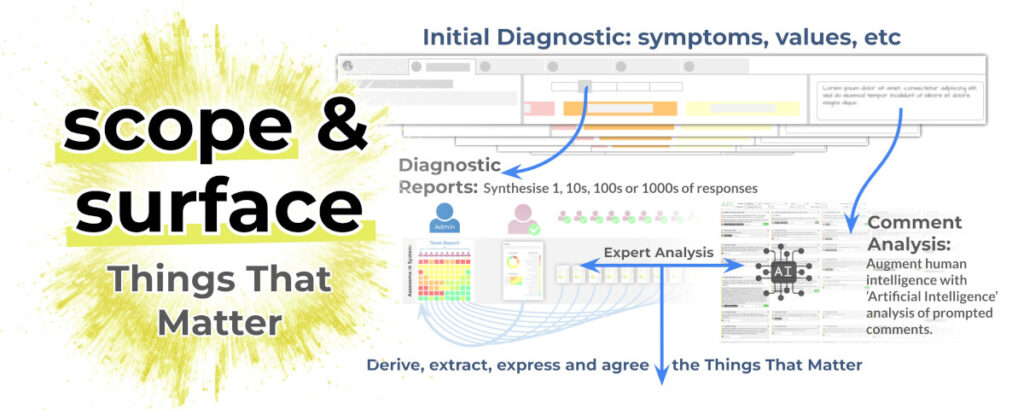
This step is all about getting the Things That Matter out and onto the table – especially the subjective ones that (as we saw in Part 2) are currently far less often in focus.
You need to start with a clear scope, and it’s then all about engagement – as widely as possible.
This is how you counteract the top-down tendencies we’ve looked at in Part 3, it makes sure that nothing is missed, and it encourages buy-in to the process – as well as a sense of ownership of what it uncovers.
There are then usually some mental blocks that people have when it comes to the Things That Matter:
- Unfamiliarity: they’re not the sorts of things normally in view when “managing” the day-to-day.
- Irrelevance: people might not see the point, because – as we saw in Part 2 – they often assume the Things That Matter are already clear and agreed.
- Skepticism: maybe Things That Matter might seem too vague.
- Reticence: maybe lots of what matters to people is currently “away from the negative”, and they might be nervous about seeming critical.
However you manage the engagement, though, you’re trying to see what Things That Matter are emerging.
2. Capturing and Refining Things That Matter
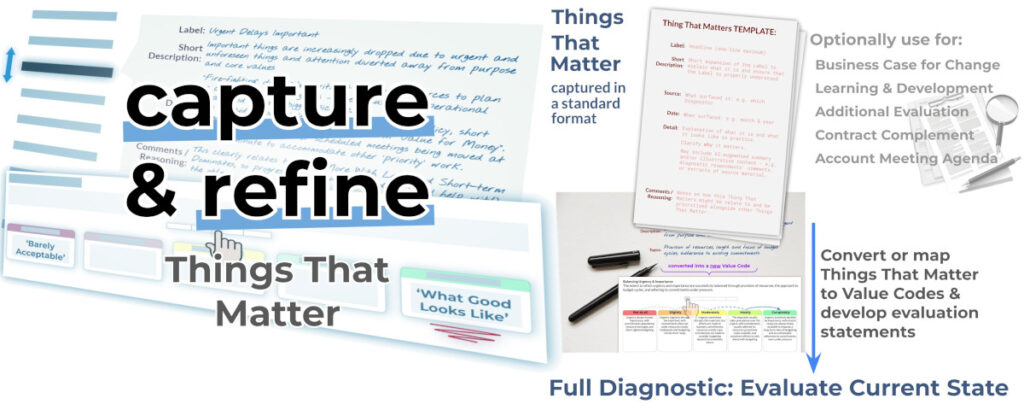
You can then Capture and Refine the Things That Matter, which is where they’re factored-out and recorded so you can start to use them.
This step is where motivation comes to the fore: you show people that they’ve really been listened-to, you create focus for them, and you show them how change can happen.
It’s where you distill down the raw material from the previous step and capture each Thing That Matters – ideally in a consistent format that’s easy to understand, and where it’s easy to use the content.
Here’s an example from the parties involved in a big facilities management contract that we helped them with, and it’s probably a familiar Thing That Matters in many situations:
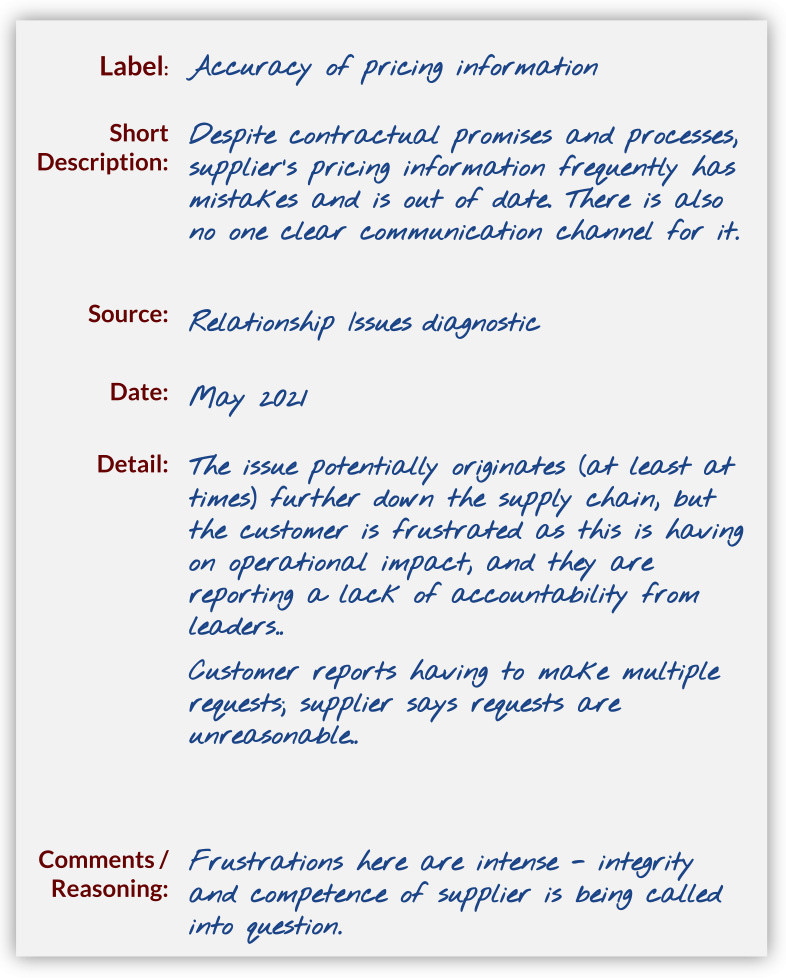
Here, it’s now a format that gives it a clear label (to refer to and identify it), explains more about what it is (to ensure clarity and understanding), explaines where it’s come from (for transparency) and gives some detail of what it means in practice (to explain relevance).
With the information in that sort of format, it becomes easier to do the things you now need to do with it:
- Identifying the priorities and aligning around them: in a relationship, that’s usually Things That Matter to both parties, and some that matter more to one of the parties, but where both prioritize them to benefit the relationship.
- Communicating the agreed Things That Matter: people then know what they are and can see they’ve been listened-to; it also creates a statement of intent – these are things you’re committing to focusing on.
- Defining how the relationship is managed: what better agenda could there be for a meeting, for example, than what the parties have agreed matters?
Most of all, you need to develop specific and objective measures for what are still mostly high-level and often subjective Things That Matter.
Now, there’s so much more that needs to be said here, and it’s maybe the most important part of the process, but in this overview it’s sufficient to explain that the general approach is to:
- Take each Thing That Matters.
- Identify all the topics or threads within it, some or all of which will be subjective.
- Create or choose one or more measures to cover these topics.
An example should make this clearer, and in this case we developed four measures – or what we call “Value Codes” – each of which covered a different aspect of the Thing That Matters, and each of which had a progressive set of statements describing what good looks like, to make it objective and measurable:
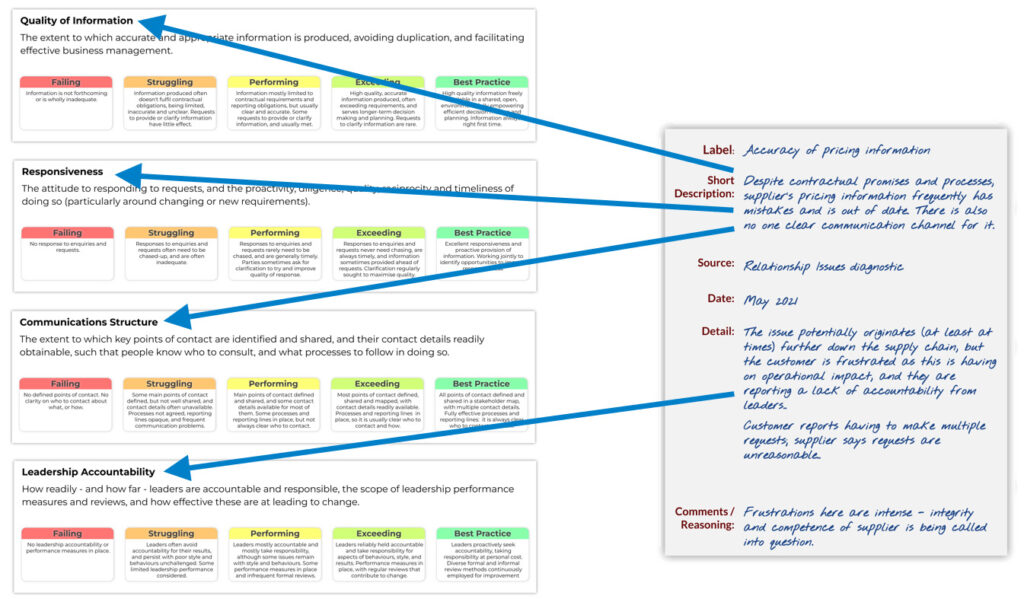
Yes, there’s an “art” to this and it’s challenging, but the key point is that it can be done, and that there’s a known process for doing it.
3. Measuring & Progressing Things That Matter
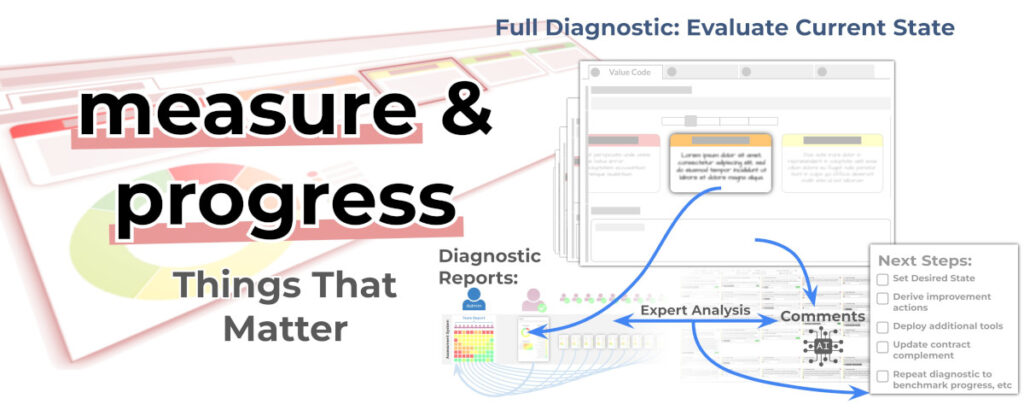
We then reach the final step – Measure and Progress – which is focused on change.
It begins with large-scale evaluation of the new measures to establish the current state for each.
This will almost certainly uncover differing perceptions to understand and address, but there are now objective evaluation statements to help do that.
Then, with broad agreement on the current state, the desired state can be targeted, it’s possible to work out what needs to happen, and to agree and complete actions.
With iterations of the process, progress hopefully gets made and you should start to see the Things That Matter being delivered-on.
So, to summarize: you surface the Things That Matter to agree them and define the situation, you put in place measures – which enables you to manage those Things That Matter, because everyone is clear and aligned – and this is what makes transformation possible.
The process addresses the gaps and issues we looked at last time, and in particular by making the subjective and intangible measurable and actionable.
But what’s behind all this? Why does this “Things That Matter” process and concept work?
This is what we’ll look at in the final part of our series.

